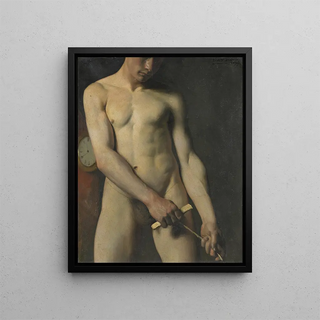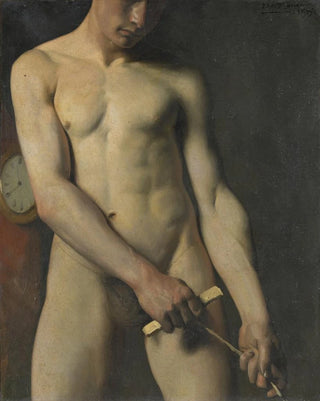Art print | Nude study of a man - Pascal-Adolphe-Jean Dagnan-Bouveret


View from behind

Frame (optional)
Pascal-Adolphe-Jean Dagnan-Bouveret’s artwork "Study of a Male Nude" offers a window into the intimacy of the human form. This painting, rooted in the 19th-century academic movement, provides a profound exploration of bodily beauty and artistic expression. The depiction of the male nude, often seen as a technical exercise by artists of the time, transcends mere anatomical study to become a true ode to human sensitivity. Through this piece, Dagnan-Bouveret not only captures physical reality but also invites viewers to reflect on beauty and art.
Style and uniqueness of the work
Dagnan-Bouveret’s style is distinguished by a remarkable mastery of light and shadow, which gives his figures an almost sculptural dimension. In "Study of a Male Nude," every muscle, every curve is rendered with precision, demonstrating an in-depth knowledge of the human body. The color nuances, ranging from warm tones to cooler shadows, create an atmosphere that is both intimate and powerful. The artist manages to breathe life into his subject, making the model not just a simple study object but a living being imbued with palpable emotion. This approach, both academic and poetic, makes the work a shining example of art’s ability to transcend time and touch the soul.
The artist and his influence
Pascal-Adolphe-Jean Dagnan-Bouveret, born in 1852, is an artist embodying the aspirations of a rapidly changing century. Trained at the École des Beaux-Arts in Paris, he is influenced by great masters of the past while seeking to renew the pictorial language of his era. His career is marked by an ongoing quest for harmony between tradition and innovation. Dagnan-Bouveret is also known for his involvement in the Symbolist movement, which advocates a more spiritual and subjective approach to art. Thus, "Study of a Male Nude" is part of a process where the artist does not

Matte finish

View from behind

Frame (optional)
Pascal-Adolphe-Jean Dagnan-Bouveret’s artwork "Study of a Male Nude" offers a window into the intimacy of the human form. This painting, rooted in the 19th-century academic movement, provides a profound exploration of bodily beauty and artistic expression. The depiction of the male nude, often seen as a technical exercise by artists of the time, transcends mere anatomical study to become a true ode to human sensitivity. Through this piece, Dagnan-Bouveret not only captures physical reality but also invites viewers to reflect on beauty and art.
Style and uniqueness of the work
Dagnan-Bouveret’s style is distinguished by a remarkable mastery of light and shadow, which gives his figures an almost sculptural dimension. In "Study of a Male Nude," every muscle, every curve is rendered with precision, demonstrating an in-depth knowledge of the human body. The color nuances, ranging from warm tones to cooler shadows, create an atmosphere that is both intimate and powerful. The artist manages to breathe life into his subject, making the model not just a simple study object but a living being imbued with palpable emotion. This approach, both academic and poetic, makes the work a shining example of art’s ability to transcend time and touch the soul.
The artist and his influence
Pascal-Adolphe-Jean Dagnan-Bouveret, born in 1852, is an artist embodying the aspirations of a rapidly changing century. Trained at the École des Beaux-Arts in Paris, he is influenced by great masters of the past while seeking to renew the pictorial language of his era. His career is marked by an ongoing quest for harmony between tradition and innovation. Dagnan-Bouveret is also known for his involvement in the Symbolist movement, which advocates a more spiritual and subjective approach to art. Thus, "Study of a Male Nude" is part of a process where the artist does not






